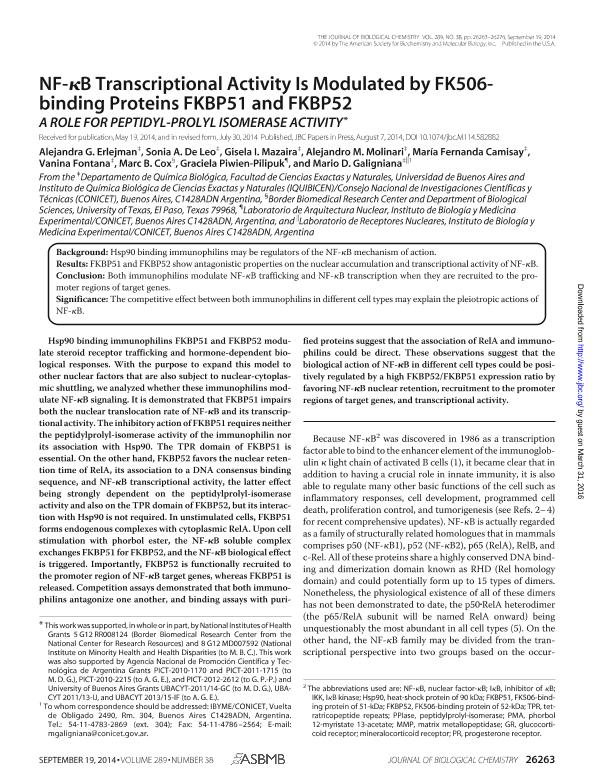Artículo
NF-κB transcriptional activity is modulated by FK506-binding proteins FKBP51 and FKBP52: a role for peptidyl-prolyl isomerase activity
Erlejman, Alejandra Giselle ; de Leo, Sonia Alejandra
; de Leo, Sonia Alejandra ; Mazaira, Gisela Ileana
; Mazaira, Gisela Ileana ; Molinari, Alejandro Martín
; Molinari, Alejandro Martín ; Camisay, Maria Fernanda
; Camisay, Maria Fernanda ; Fontana, Vanina Andrea
; Fontana, Vanina Andrea ; Cox, Mark; Piwien Pilipuk, Graciela
; Cox, Mark; Piwien Pilipuk, Graciela ; Galigniana, Mario Daniel
; Galigniana, Mario Daniel
 ; de Leo, Sonia Alejandra
; de Leo, Sonia Alejandra ; Mazaira, Gisela Ileana
; Mazaira, Gisela Ileana ; Molinari, Alejandro Martín
; Molinari, Alejandro Martín ; Camisay, Maria Fernanda
; Camisay, Maria Fernanda ; Fontana, Vanina Andrea
; Fontana, Vanina Andrea ; Cox, Mark; Piwien Pilipuk, Graciela
; Cox, Mark; Piwien Pilipuk, Graciela ; Galigniana, Mario Daniel
; Galigniana, Mario Daniel
Fecha de publicación:
08/2014
Editorial:
American Society for Biochemistry and Molecular Biology
Revista:
Journal of Biological Chemistry (online)
ISSN:
0021-9258
e-ISSN:
1083-351X
Idioma:
Inglés
Tipo de recurso:
Artículo publicado
Clasificación temática:
Resumen
Hsp90 binding immunophilins FKBP51 and FKBP52 modulate steroid receptor trafficking and hormone-dependent biological responses. With the purpose to expand this model to other nuclear factors that are also subject to nuclear-cytoplasmic shuttling, we analyzed whether these immunophilins modulate NF-κB signaling. It is demonstrated that FKBP51 impairs both the nuclear translocation rate of NF-κB and its transcriptional activity. The inhibitory action of FKBP51 requires neither the peptidylprolyl-isomerase activity of the immunophilin nor its association with Hsp90. The TPR domain of FKBP51 is essential. On the other hand, FKBP52 favors the nuclear retention time of RelA, its association to a DNA consensus binding sequence, and NF-κB transcriptional activity, the latter effect being strongly dependent on the peptidylprolyl-isomerase activity and also on the TPR domain of FKBP52, but its interaction with Hsp90 is not required. In unstimulated cells, FKBP51 forms endogenous complexes with cytoplasmic RelA. Upon cell stimulation with phorbol ester, the NF-κB soluble complex exchanges FKBP51 for FKBP52, and the NF-κB biological effect is triggered. Importantly, FKBP52 is functionally recruited to the promoter region of NF-κB target genes, whereas FKBP51 is released. Competition assays demonstrated that both immunophilins antagonize one another, and binding assays with purified proteins suggest that the association of RelA and immunophilins could be direct. These observations suggest that the biological action of NF-κB in different cell types could be positively regulated by a high FKBP52/FKBP51 expression ratio by favoring NF-κB nuclear retention, recruitment to the promoter regions of target genes, and transcriptional activity.
Archivos asociados
Licencia
Identificadores
Colecciones
Articulos(IBYME)
Articulos de INST.DE BIOLOGIA Y MEDICINA EXPERIMENTAL (I)
Articulos de INST.DE BIOLOGIA Y MEDICINA EXPERIMENTAL (I)
Articulos(IQUIBICEN)
Articulos de INSTITUTO DE QUIMICA BIOLOGICA DE LA FACULTAD DE CS. EXACTAS Y NATURALES
Articulos de INSTITUTO DE QUIMICA BIOLOGICA DE LA FACULTAD DE CS. EXACTAS Y NATURALES
Citación
Erlejman, Alejandra Giselle; de Leo, Sonia Alejandra; Mazaira, Gisela Ileana; Molinari, Alejandro Martín; Camisay, Maria Fernanda; et al.; NF-κB transcriptional activity is modulated by FK506-binding proteins FKBP51 and FKBP52: a role for peptidyl-prolyl isomerase activity; American Society for Biochemistry and Molecular Biology; Journal of Biological Chemistry (online); 289; 38; 8-2014; 26263-26276
Compartir
Altmétricas
Items relacionados
Mostrando titulos relacionados por título, autor y tema.
-
Mayol, Gonzalo Federico ; Defelipe, Lucas Alfredo ; Arcon, Juan Pablo ; Turjanski, Adrian ; Marti, Marcelo Adrian (American Chemical Society, 2022-08)
-
Uhart, Marina ; Flores, Gabriel; Bustos, Diego Martin (Nature Publishing Group, 2016-05)
-
Fernández, Julián Francisco; Lavecchia, Martín José (Taylor & Francis, 2020-12-28)



